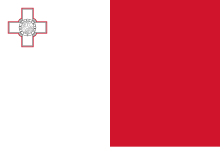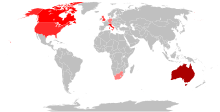مردم مالتی
 | |
 نقشهٔ مردم مالتی در سراسر جهان | |
| کل جمعیت | |
|---|---|
| ح.۴۰۰٬۰۰۰–۷۰۰٬۰۰۰[a] | |
| مناطق با جمعیت چشمگیر | |
| ۱۹۸٬۹۹۶[۲] | |
| ۴۱٬۹۲۰[۳] | |
| ۴۰٬۲۳۰[۴] | |
| ۴۰٬۸۲۰ (2016)[۵] | |
| ۳۱٬۰۰۰[۶] | |
| ۱٬۰۰۰[۷] | |
| ۱٬۰۰۰[۸] | |
| ~۱٬۰۰۰–۲٬۰۰۰[۹][۱۰] | |
| زبانها | |
| مالتی انگلیسی • ایتالیایی | |
| دین | |
| عمدتاً کاتولیک رومی[۱۱][۱۲] | |
a رقم کل صرفاً تخمینی از تمام جمعیتهای ارجاع شده است. | |
مردم مالتی (مالتی: Maltin) قومیت بومی و ساکن کشور مالت هستند که به زبان مالتی، یک زبان سامی سخن میگویند و دارای فرهنگ و تاریخ مالتی یکسان هستند. مالت، کشوری جزیرهای در دریای مدیترانه است که یک مجمعالجزایر شامل جزیرهای به همین نام، جزیره غودش (مالتی: Għawdex) و جزیره کمینو (مالتی: Kemmuna) است؛ مردم غودش (مالتی: Għawdxin) به عنوان زیرگروهی از مالتیها بهشمار میروند.
تاریخ
[ویرایش]مردم کنونی مالت، که با بهکار بردن زبان مالتی و آیین کلیسای کاتولیک شناخته میشوند، بازماندگان مهاجران از سیسیل و کالابریا هستند که در سرآغاز هزارهٔ دوم و پس از سپری شدن دو سده کاهش جمعیت به دنبال حملهٔ افریقیهای به دست اغلبیان در ۸۷۰ میلادی، ساکن جزیره شدند.[۱۳][۱۴] تحقیقات ژنتیکی نشان میدهد مالت در آغاز سدهٔ دهم به سختی مسکونی بود و احتمالاً ساکنان عربی سیسیلیزبان از سیسیل و کالابریا آن را مسکونی کردند.[۱۵][۱۶] از آنجایی که اکثر جای نامها از بین رفتند و جایگزین شدند، ساکنان پیشین جزیره، فنیقیها، رومیها و بیزانسیها، اثری باقی نذاشتند. نورمنها در سال ۱۰۹۱ جزیره را فتح کردند و تا سال ۱۲۴۹ آن را کاملاً باری دیگر مسیحیسازی کردند.[۱۷] این مسیحیسازی، شرایط لازم برای تکامل زبان مالتی از گویش منقرضشدهٔ عربی سیسیلی را به وجود آورد.[۱۸]
زبان
[ویرایش]
مردم مالتی به زبان مالتی سخن میگویند، که یک زبان بومی ترکیبی منحصر به فرد اساساً سامی است اما دارای رولایهٔ رومی (ایتالیایی) است و در حالت معیار به الفبای لاتین نوشته میشود. این زبان بازماندهٔ زبان عربی سیسیلی، یک گویش منقرضشدهٔ عربی است که در سیسیل توسط مردم بومی که آن زمان از دیدگاه دینی مجزا بر مسیحیان آیین یونانی و مسلمانانی که نیاکان آنان از مسیحیت روی آورده بودند، سخن گفته میشد.[۱۹] در طول تاریخ، این زبان بخش زیادی وامواژه از سیسیلی و ایتالیایی و در درجهٔ کمتر از انگلیسی و فرانسوی گرفته است.
مالتی در سال ۱۹۳۴، زبان رسمی مالت شد و در کنار انگلیسی جایگزین ایتالیایی شد. حدود ۳۷۱٬۹۰۰ نفر در جزیره سخنوران این زبان هستند و آمار نشان میدهد ۱۰۰٪ مردم به مالتی، ۸۸٪ به انگلیسی، ۶۶٪ به ایتالیایی و ۱۷٪ به فرانسوی سخن میگویند. این آمار نشاندهندهٔ درجه بیشتری از توانایی زبانی نسبت به دیگر کشورهای اروپایی است.[۲۰] در واقع، چندزبانگی در مالت یک پدیدهٔ رایج است و انگلیسی و گاهی ایتالیایی در روزمرگی به کار میرود. در حالی که مالتی زبان ملی است، گمان میرود برتری زبان انگلیسی ممکن است منجر به جایگزینی زبان شود؛[۲۱][۲۲] با این حال یک نظرسنجی در سال ۲۰۰۵ نشان داد مالتی زبان مادری ۹۷٪ مردم در مالت است.[۲۳]
دین
[ویرایش]قانون اساسی مالت آزادی ادیان را فراهم میکند اما کیش کاتولیک رومی را به عنوان دین رسمی میشناسد.[۲۴] در اعمال رسولان، مالت به عنوان جایی شناخته میشود که پولس رسول در راه روم کشتیاش غرق شد. طبق گزارش خانه آزادی و کتاب حقایق جهانی، ۹۸٪ مردم مالت کاتولیک هستند که این کشور را یکی از کاتولیکترین کشورهای جهان از لحاظ جمعیتی میکند.[۲۵]
پانویس
[ویرایش]- ↑ Census of population and housing 2021 بایگانیشده در ۲۰۲۲-۰۸-۰۹ توسط Wayback Machine. pp. 30. National Statistics Office of Malta
- ↑ "Australia General Community Profile". Australian Bureau of Statistics. Retrieved 28 June 2022.
- ↑ "Census Profile, 2016 Census: Ethnic origin population". Statistics Canada. Retrieved 3 December 2021.
- ↑ "Population data". OECD. Archived from the original (xls) on 2009-06-17.
- ↑ "2016 American Community Survey 1-year estimates". Retrieved 2018-05-18.
- ↑ "Italy | Joshua Project".
- ↑ "Immigrant and Emigrant Populations by Country of Origin and Destination". 10 February 2014.
- ↑ "Immigrant and Emigrant Populations by Country of Origin and Destination". 10 February 2014.
- ↑ "Maltese living in Turkey celebrate traditional feast". 20 September 2015.
- ↑ "The Great Exodus (Maltese in Turkey from Lancs to the Levant)". 10 March 2015.
- ↑ "Malta". State.gov. 1 January 2004. Retrieved 17 August 2012.
- ↑ Sansone, Kurt (16 February 2023). "Census 2021: Maltese citizens overwhelmingly identify as Roman Catholics". Malta Today. Archived from the original on 17 January 2024.
- ↑ "Gozo". IslandofGozo.org. 7 October 2007. Archived from the original on 22 August 2008.
- ↑ So who are the 'real' Maltese. 14 September 2014.
There’s a gap between 800 and 1200 where there is no record of civilisation. It doesn’t mean the place was completely uninhabited. There may have been a few people living here and there, but not much……..The Arab influence on the Maltese language is not a result of Arab rule in Malta, Prof. Felice said. The influence is probably indirect, since the Arabs raided the island and left no-one behind, except for a few people. There are no records of civilisation of any kind at the time. The kind of Arabic used in the Maltese language is most likely derived from the language spoken by those that repopulated the island from Sicily in the early second millennium; it is known as Siculo-Arab. The Maltese are mostly descendants of these people.
- ↑ So who are the 'real' Maltese. 14 September 2014.
There’s a gap between 800 and 1200 where there is no record of civilisation. It doesn’t mean the place was completely uninhabited. There may have been a few people living here and there, but not much……..The Arab influence on the Maltese language is not a result of Arab rule in Malta, Prof. Felice said. The influence is probably indirect, since the Arabs raided the island and left no-one behind, except for a few people. There are no records of civilisation of any kind at the time. The kind of Arabic used in the Maltese language is most likely derived from the language spoken by those that repopulated the island from Sicily in the early second millennium; it is known as Siculo-Arab. The Maltese are mostly descendants of these people.
- ↑ Genetic Origin of Contemporary Maltese People. 5 August 2007.
Repopulation is likely to have occurred by a clan or clans (possibly of Arab or Arab-like speaking people) from neighbouring Sicily and Calabria. Possibly, they could have mixed with minute numbers of residual inhabitants, with a constant input of immigrants from neighbouring countries and later, even from afar. There seems to be little input from North Africa.
- ↑ The origin of the Maltese surnames.
Ibn Khaldun puts the expulsion of Islam from the Maltese Islands to the year 1249. It is not clear what actually happened then, except that the Maltese language, derived from Arabic, certainly survived. Either the number of Christians was far larger than Giliberto had indicated, and they themselves already spoke Maltese, or a large proportion of the Muslims themselves accepted baptism and stayed behind. Henri Bresc has written that there are indications of further Muslim political activity on Malta during the last Suabian years. Anyhow there is no doubt that by the beginning of Angevin times no professed Muslim Maltese remained either as free persons or even as serfs on the island.
- ↑ Joseph M. Brincat (Feb 2005). "Maltese – an unusual formula". MED Magazine. Archived from the original on Apr 1, 2023.
Originally Maltese was an Arabic dialect but it was immediately exposed to Latinisation because the Normans conquered the islands in 1090, while Christianisation, which was complete by 1250, cut off the dialect from contact with Classical Arabic. Consequently Maltese developed on its own, slowly but steadily absorbing new words from Sicilian and Italian according to the needs of the developing community.
- ↑ "MED Magazine". 9 May 2008. Archived from the original on 9 May 2008. Retrieved 12 January 2017.
{{cite web}}: نگهداری یادکرد:ربات:وضعیت نامعلوم پیوند اصلی (link) - ↑ "Europeans and their Languages" (PDF). Ec.europa.eu. Retrieved 12 December 2017.
- ↑ "Archived copy" (PDF). Archived from the original (PDF) on 2006-09-19. Retrieved 2006-12-04.
{{cite web}}: نگهداری یادکرد:عنوان آرشیو به جای عنوان (link) - ↑ European Commission, "Malta: Country Profile", Euromosaic Study (September 2004)
- ↑ "EUROPEANS AND LANGUAGES" (PDF). Ec.europa.eu. Archived from the original (PDF) on 28 January 2007. Retrieved 12 December 2017.
- ↑ "Chapter 1 – The Republic of Malta". Legal-Malta. Archived from the original on 27 August 2011. Retrieved 4 September 2011.
- ↑ "Catholic Church in Malta". GCatholic.org. Retrieved 17 August 2012.
منابع
[ویرایش]- Bonanno A. (2005). Malta: Phoenician, Punic and Roman. Midsea Books: Valletta.
